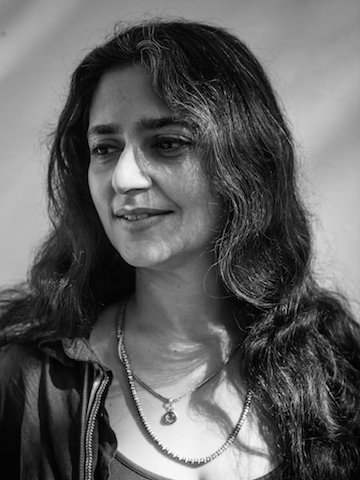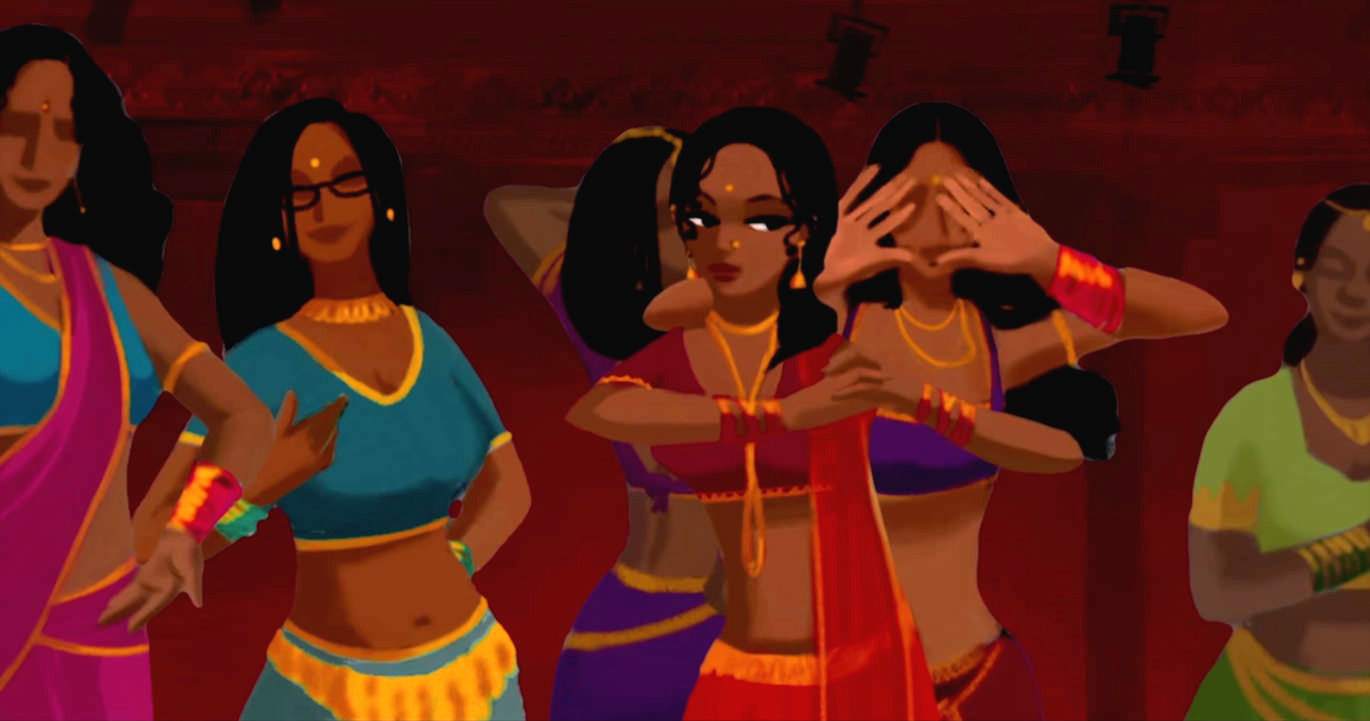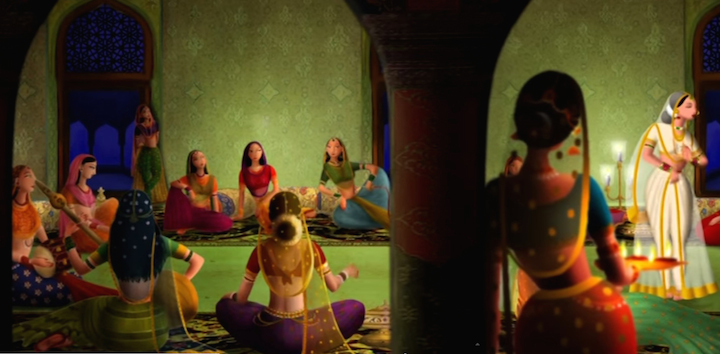True Love Story © Gitanjali Rao
Gitanjali Rao’s work is proof that great art sometimes lies hidden, and there is sheer joy in discovering it. Rao is one of the most talented Indian filmmakers you’ve probably never heard of. Her films have premiered at Cannes, traveled to over a hundred film festivals around the world and won numerous international awards (almost making the Academy Awards in 2008). The reason it may not ring a bell? She works primarily in a quiet, niche space –experimental animation.

An artist ahead of her time, Rao is probably the best thing to happen to Indian animation since “Ek chidiya, anek chidiya”. In a country where mainstream Bollywood and regional films saturate every available entertainment slot, she is chipping away underground, toiling for years, to create each of her poetic and mesmerizing short films.
Her latest short True Love Story is a love-letter to the city of Bombay – its sights and sounds mixing together harmoniously like a familiar piece of orchestra. Within it, she weaves a beautiful love story between two poor migrants. As it makes the rounds of film festivals around the world, she tells us about her artistic journey and why she is so inspired by the spirit of Bombay.
Tell us a little bit about your journey that led you into the world of animation?
I graduated with an Applied Art degree from Sir JJ Institute of Applied Art in 1994 –a time when pursuing fine arts was not much of a career option. I was always interested in making films and in painting. Not in advertising. I became aware of animation as a medium when I saw a retrospective of a Polish animation film maker Jerzy Kucia at the Bombay International Film festival –the only venue to watch world cinema back then. I was mesmerized by the medium and its poetry and its ability in bringing together painting and film making. I decided to explore and joined one of the only animation studios then, Ram Mohan Biographics. I learned the basics and conventions of animation there. Then I proceeded to work with different animators and animation studios for 8 years, learning and perfecting the craft. Then naturally, I moved on to finally making my own little short films.
“All my long waits at traffic signals while traveling in buses, taxis and rickshaws have made me collect its sounds, visuals, stories, characters and their lives to be able to pour them out into a film.”

In many ways, True Love Story feels like a celebration of the sights and sounds of Mumbai. There is rich visual detail in every frame, rendering the city as its own character. Can you tell us about your vision when you set out to make this film?
I have lived all my life in Bombay, leaving it for not more than four months at the longest. It seems to be in my blood and senses without making an effort. As a painter, I have an eye for detail and characteristics which I never stop practicing upon. I feel that, that is what makes animation say more than live-action. My films do not have narratives or dialogues. Therefore I try to tell stories through visuals and sounds. All my long waits at traffic signals while traveling in buses, taxis and rickshaws have made me collect its sounds, visuals, stories, characters and their lives to be able to pour them out into a film.
“A few people become success stories and the city celebrates them . But a large percentage of people remain in the margins, building the city, cleaning the city, feeding the city and yet they are treated as outlaws and constantly eradicated. Their struggle to survive each day is inhuman and yet they do. They seem to me as bigger heroes than the Bachchans or the Khans“
Girgit © Gitanjali Rao
You seem to have a special interest in the stories of migrant workers and street vendors in Mumbai. Your films Girgit and Chai explore these themes. The central characters in True Love Story are also struggling to make ends meet. Tell us about these inspirations.
Quite like New York or any big cosmopolitan city, Bombay is made up of people who come and settle from outside. Some –a new generation, some –a few generations ago, like my family. Just about everybody comes from somewhere else and makes this city work. The question that follows “What’s your name?” is “Where are you from?”. This is unique yet commonplace. A few people become success stories and the city celebrates them . But a large percentage of people remain in the margins, building the city, cleaning the city, feeding the city and yet they are treated as outlaws and constantly eradicated. Their struggle to survive each day is inhuman and yet they do. They seem to me as bigger heroes than the Bachchans or the Khans who are as much a migrant to the city as them. Somebody needs to tell these stories, is what I feel. Besides, the fact is that their spirit is something I can never stop admiring and getting inspired by –the under-privileged who ‘make’ this city.
The sound design and mixing in True Love Story is brilliant. Tell us about your process.
My process is nothing more than having one of the best sound designers, National Award winner PM Satheesh as a friend! We have worked together in the past and he inspires me to think of sound differently. I surrender my visuals to his sound and the magic happens! We simply have similar sensibilities that we enjoy stretching to the fullest, given the medium. Unlike live-action films, that come to sound designers, animation films come without any sound track at all. So it begins and ends with needing to use imagination. Most sound designers feel lost in this silent space. PM Satheesh is most at home here.

You have a very beautiful and distinct style. You’ve also animated small portions in your films in the style of Rajput paintings. Do the traditional art forms inspire you?
Yes, I love animating to different Indian art styles. Miniature paintings ( Mughal and Kangra style) are fascinating and extremely difficult. But these have an ability to recreate a lost time and its dreamlike beauty we know only from poetry and paintings. My animation is also inspired by shadow puppets from Karnataka, truck art etc.
“Miniature paintings ( Mughal and Kangra style) are fascinating and extremely difficult. But these have an ability to recreate a lost time and its dreamlike beauty we know only from poetry and paintings.”
You rarely use dialogue in your animated films (we only heard characters speak in Orange). Tell us about that choice.
I like to tell stories through paintings that move. Visually. Not having dialogues makes it more challenging and therefore more enjoyable. I also like the audience to hear the voices in their minds and not spell out things to them.

How long did it take to finish True Love Story? And which of your films took the longest?
True Love Story was an idea that I worked upon for years before I started animating it. The animation process took one and a half years. Printed rainbow was the longest; it took three years to make.
Printed Rainbow is such a heartwarming tale of an old woman who’s happy to live inside her childlike vivid imagination, with an adorable cat. How did you come up with the amazing matchbox art theme?
I hate to disappoint people when they ask me this question, but it was just a ploy –something better than stamps which I thought of in order to take the old lady into journeys through different lands. I know people would rather be told, it was a passion for matchboxes (which I never collected) that led me to make the film. The truth is, when thinking of stories, this is a natural process of using ploys which have not been used before or not been done to death.
Printed Rainbow © Gitanjali Rao
In India, animation has not yet been able to cross-over from being children’s entertainment to a serious alternative cinematic medium. Do you struggle with that reality?
Yes I do. That’s the reason I have not been able to make the three feature films I have been working and pursuing for the last 7 years! But I hope it will change over time.
‘True Love Story’ was screened at Cannes Critics Week, 2014 and the Indian Film Festival of Los Angeles (IFFLA), 2015. Gitanjali Rao has independently produced, directed and animated award winning short films, ‘Orange’ and ‘Printed Rainbow’. ‘Printed Rainbow’ won three Awards for Best Short film at Cannes Critics week, 2006. It was also among the last ten films short-listed for the Academy Awards in 2008, besides winning 25 International Awards.















